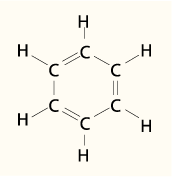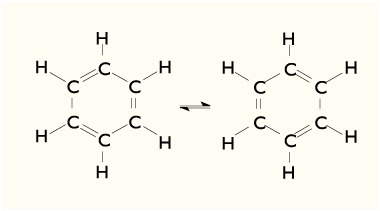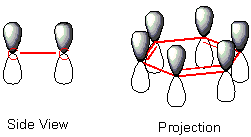The
chemical compound benzene (C6H6)
is a colorless, flammable, aromatic hydrocarbon, that
is a known carcinogen. It boils at 80.1°C and melts
at 5.5°C. Benzene has a heat of vaporization of 44.3
kJ/mol and a heat of fusion of 9.84 kJ/mol. Produced
by hydrogen reduction of some allotropes of carbon, or from
petroleum, it is used in the creation of drugs, plastics, gasoline, synthetic rubber, napalm and dyes.
The chemist Kekulé was the first to deduce the ring structure of benzene; after years of studying carbon bonding, benzene and related molecules, the solution to the benzene structure came to him in a dream of a snake eating its own tail. Upon waking was inspired to deduce the ring structure of benzene.
While his claims were well publicized and accepted, by the early 1920s Kekulé's biographer came to the conclusion that Kekulé's understanding of the tetravalent nature carbon bonding depended on the previous research of Archibald Scott Couper (1831-1892); further, the German Chemist Josef Loschmidt (1821-1895) had earlier posited a cyclic structure for benzene as early as 1862, although he had not actually proved this structure to be correct.
Benzene presents a problem, as to account for all the bonds in the molecule, there must be alternating double carbon bonds:
 Benzene Molecular Structure
Benzene Molecular Structure
However, all of the carbon-carbon bonds in the benzene molecule are of the same length, and it is known that a single bond is longer than a double bond. In addition, the bond length (the distance between the two bonded atoms) in benzene is greater than a double bond, but shorter than a single bond. There seems in effect to be a bond and a half between each carbon.
This is explained by electron delocalization. In order to picture this, we must consider the position of electrons in the bonds of benzene.
One representation is that the structure of the benzene molecule exists as a superposition of the forms below, rather than either form individually. This type of structure is called a resonance hybrid of the benzene molecule.

In reality, neither form really exists. Delocalisation must be explained using a higher level of theory than single and double bonds. The single bonds are formed with electrons in line between the carbon atoms - this is called à (sigma) symmetry. Double bonds consist of a sigma bond and another, À (pi) bond. This second bond has electrons orbiting in paths above and below the plane of the ring at each bonded carbon atom. The À-bonds are formed from atomic p-orbitals above and below the plane of ring. The following diagram shows the positions of these p-orbitals in the benzene molecule:

Being out of the plane of the atoms, these orbitals can interact with each other freely, and become delocalised. This means that instead of being tied to one atom of carbon, each electron is shared by all six in the ring. Thus there are not enough to form double bonds on all the carbon atoms, but the "extra" electrons do strengthen all of the bonds on the ring equally. The resulting molecular orbital has À symmetry.
This delocalisation of electrons is known as aromaticity, and gives benzene great stability. This is the fundamental property of aromatic chemicals which differentiates them from non aromatics.
To reflect the delocalised nature of the bonding, the benzene molecule may be depicted as a circle inside a hexagon in chemical structure diagrams.
As with most diagrams of molecular structures, the Hydrogen atoms are frequently omitted.
Substituents
Many important chemicals are essentially benzene, with one or more of the hydrogen atoms replaced with some other functionality, eg:
Hydrocarbon Substituents
The major effect of benzene from chronic (long term) exposure is to the blood. Benzene causes harmful effects on the bone marrow and can cause a decrease in red blood cells leading to anemia. It can also cause excessive bleeding and can affect the immune system, increasing the chance of infection. Some women who breathed high levels of benzene for many months had irregular menstrual periods and a decrease in the size of their ovaries. It is not known whether benzene exposure affects the developing fetus in pregnant women or fertility in men. Animal studies have shown low birth weights, delayed bone formation, and bone marrow damage when pregnant animals breathed benzene.
The US Department of Health and Human Services (DHHS) has determined that benzene is a known human carcinogen. Long-term exposure to high levels of benzene in the air can cause leukemia, cancer of the blood-forming organs.
Several tests can show if you have been exposed to benzene. There is test for measuring benzene in the breath; this test must be done shortly after exposure. Benzene can also be measured in the blood; however, since benzene disappears rapidly from the blood, measurements are accurate only for recent exposures.
In the body, benzene is metabolized. Certain metabolites can be measured in the urine. However, this test must be done shortly after exposure and is not a reliable indicator of how much benzene you have been exposed to, since the same metabolites may be present in urine from other sources.
The US Environmental Protection Agency has set the maximum permissible level of benzene in drinking water at 0.005 milligrams per liter (0.005 mg/L). The EPA requires that spills or accidental releases into the environment of 10 pounds or more of benzene be reported to the EPA.
The US Occupational Safety and Health Administration (OSHA) has set a permissible exposure limit of 1 part of benzene per million parts of air (1 ppm) in the workplace during an 8-hour workday, 40-hour workweek.
Structure
The formula of benzene (C6H6), caused a mystery for some time after its discovery, as no proposed structure could take account of all the bonds (carbon usually forms four single bonds and hydrogen one).The chemist Kekulé was the first to deduce the ring structure of benzene; after years of studying carbon bonding, benzene and related molecules, the solution to the benzene structure came to him in a dream of a snake eating its own tail. Upon waking was inspired to deduce the ring structure of benzene.
While his claims were well publicized and accepted, by the early 1920s Kekulé's biographer came to the conclusion that Kekulé's understanding of the tetravalent nature carbon bonding depended on the previous research of Archibald Scott Couper (1831-1892); further, the German Chemist Josef Loschmidt (1821-1895) had earlier posited a cyclic structure for benzene as early as 1862, although he had not actually proved this structure to be correct.
Benzene presents a problem, as to account for all the bonds in the molecule, there must be alternating double carbon bonds:
 Benzene Molecular Structure
Benzene Molecular Structure
However, all of the carbon-carbon bonds in the benzene molecule are of the same length, and it is known that a single bond is longer than a double bond. In addition, the bond length (the distance between the two bonded atoms) in benzene is greater than a double bond, but shorter than a single bond. There seems in effect to be a bond and a half between each carbon.
This is explained by electron delocalization. In order to picture this, we must consider the position of electrons in the bonds of benzene.
One representation is that the structure of the benzene molecule exists as a superposition of the forms below, rather than either form individually. This type of structure is called a resonance hybrid of the benzene molecule.

In reality, neither form really exists. Delocalisation must be explained using a higher level of theory than single and double bonds. The single bonds are formed with electrons in line between the carbon atoms - this is called à (sigma) symmetry. Double bonds consist of a sigma bond and another, À (pi) bond. This second bond has electrons orbiting in paths above and below the plane of the ring at each bonded carbon atom. The À-bonds are formed from atomic p-orbitals above and below the plane of ring. The following diagram shows the positions of these p-orbitals in the benzene molecule:

Being out of the plane of the atoms, these orbitals can interact with each other freely, and become delocalised. This means that instead of being tied to one atom of carbon, each electron is shared by all six in the ring. Thus there are not enough to form double bonds on all the carbon atoms, but the "extra" electrons do strengthen all of the bonds on the ring equally. The resulting molecular orbital has À symmetry.
This delocalisation of electrons is known as aromaticity, and gives benzene great stability. This is the fundamental property of aromatic chemicals which differentiates them from non aromatics.
To reflect the delocalised nature of the bonding, the benzene molecule may be depicted as a circle inside a hexagon in chemical structure diagrams.
As with most diagrams of molecular structures, the Hydrogen atoms are frequently omitted.
Substituents
Many important chemicals are essentially benzene, with one or more of the hydrogen atoms replaced with some other functionality, eg:
Hydrocarbon Substituents
- toluene
- xylene
- mesitylene
- trinitrotoluene
- phenol
- picric acid
- aniline
- naphthalene
- anthracene
- phenanthrene
- pyridine is the most commonly encountered heterocycle, due to its aromaticity
- furan is not stable, due to its electronic configuration; it is not aromatic. The derivative tetrahydrofuran (THF) is very widely used as a solvent and reagent.
Production
Benzene may result whenever carbon-rich materials undergo incomplete combustion. It is produced naturally in volcanoes and forest fires, and is also a component of cigarette smoke. Industrially, it is produced from either coal or petroleum. The steel industry 'cokes' coal. This coke is then 'cracked' to yield Benzene(63%), Toluene(14%) & Xylene(7%). Alternatively an Olefin plant will produce Benzene as a by-product of cracking naptha or gas oil. It is one of the components of the coal tars given off when coal in converted to coke. Up until World War II, this source of benzene was sufficient to meet world demand for the chemical. However, in the 1950's, increasing demand for benzene, especially for the growing plastics necessitated the production of benzene from petroleum. Today, most benzene comes from the petrochemical industry, with only a small fraction being produced from coal.Uses
Prior to the 1920's, benzene was frequently used as an industrial solvent, especially for degreasing metal. As its toxicity became obvious, other solvents replaced benzene in application that directly exposed the user to benzene. As a gasoline additive, benzene increases the octane rating and reduces knocking. As a result, gasoline once often contained several percent benzene, although in the 1950s tetraethyl lead replaced it as the most widely used antiknock additive. However, with the global phaseout of leaded gasoline, benzene has made a comeback as a gasoline additive in some nations. In the United States, concern over its negative health effects and the possibility of benzene entering the groundwater have led to stringent regulation of gasoline's benzene content. Many European nations, on the other hand, either do not regulate benzene in gasoline or allow significant quantities of it, and European gasoline formulations often contain 5% or more benzene. By far the largest use of benzene is an intermediate to make other chemicals. The most widely produced derivatives of benzene are styrene, which is used to make polymers and plastics phenol for resins and adhesives (via cumene), and cyclohexane, which is used in Nylon manufacture. Smaller amounts of benzene are used to make some types of rubbers, lubricants, dyes, detergents, drugs, explosives and pesticides.Health effects
Breathing very high levels of benzene can result in death, while high levels can cause drowsiness, dizziness, rapid heart rate, headaches, tremors, confusion, and unconsciousness. Eating or drinking foods containing high levels of benzene can cause vomiting, irritation of the stomach, dizziness, sleepiness, convulsions, rapid heart rate, and death.The major effect of benzene from chronic (long term) exposure is to the blood. Benzene causes harmful effects on the bone marrow and can cause a decrease in red blood cells leading to anemia. It can also cause excessive bleeding and can affect the immune system, increasing the chance of infection. Some women who breathed high levels of benzene for many months had irregular menstrual periods and a decrease in the size of their ovaries. It is not known whether benzene exposure affects the developing fetus in pregnant women or fertility in men. Animal studies have shown low birth weights, delayed bone formation, and bone marrow damage when pregnant animals breathed benzene.
The US Department of Health and Human Services (DHHS) has determined that benzene is a known human carcinogen. Long-term exposure to high levels of benzene in the air can cause leukemia, cancer of the blood-forming organs.
Several tests can show if you have been exposed to benzene. There is test for measuring benzene in the breath; this test must be done shortly after exposure. Benzene can also be measured in the blood; however, since benzene disappears rapidly from the blood, measurements are accurate only for recent exposures.
In the body, benzene is metabolized. Certain metabolites can be measured in the urine. However, this test must be done shortly after exposure and is not a reliable indicator of how much benzene you have been exposed to, since the same metabolites may be present in urine from other sources.
The US Environmental Protection Agency has set the maximum permissible level of benzene in drinking water at 0.005 milligrams per liter (0.005 mg/L). The EPA requires that spills or accidental releases into the environment of 10 pounds or more of benzene be reported to the EPA.
The US Occupational Safety and Health Administration (OSHA) has set a permissible exposure limit of 1 part of benzene per million parts of air (1 ppm) in the workplace during an 8-hour workday, 40-hour workweek.
No comments:
Post a Comment